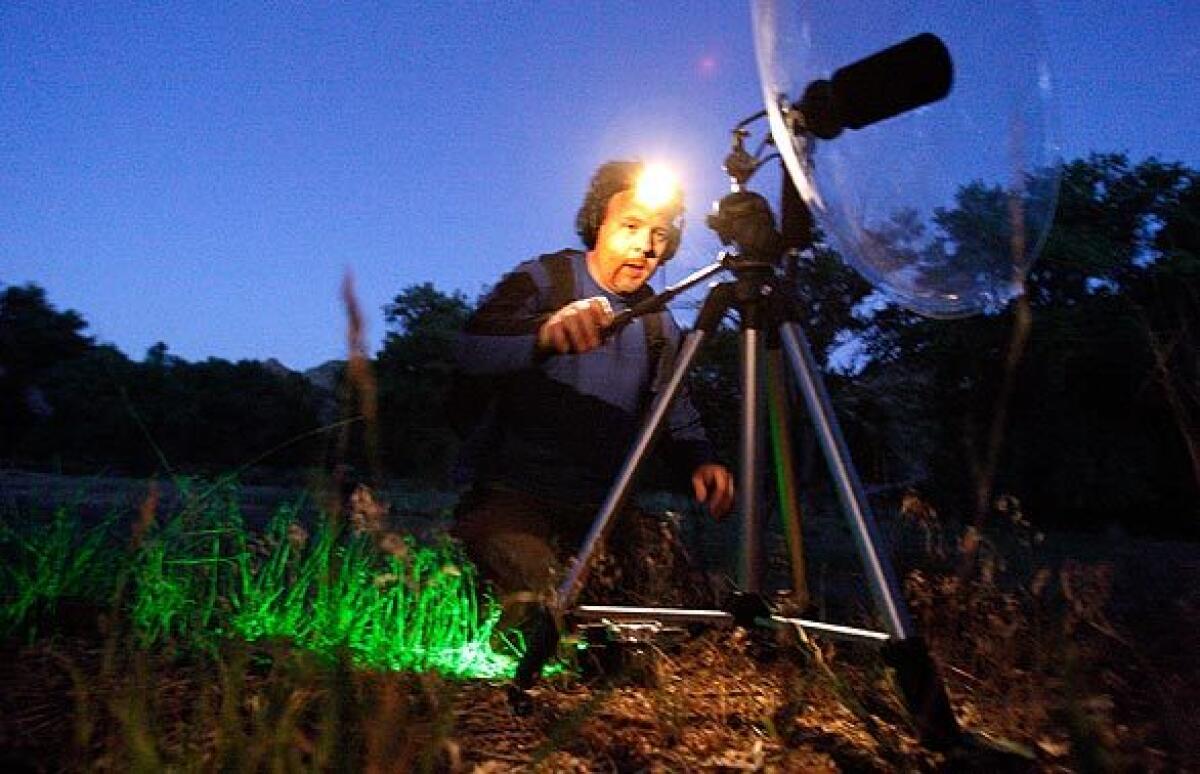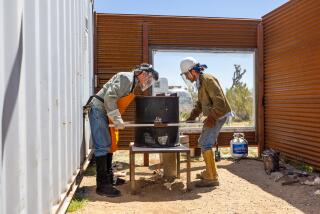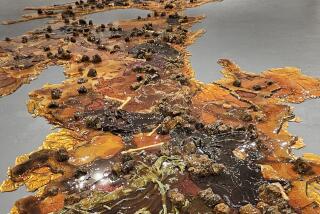Recording the sounds of the West

Reporting from Range Creek, Utah — A synthesized cellphone melody pulls Jeff Rice from his sleep.
De-de da-de-de da-de-de da-de. De-de da-de-de da-de-de da-de.
Rice hits the alarm. It’s 4:30, still dark. He clicks on his headlamp and dresses in the confines of his tent.
The nylon zipper shrieks -- zzzzzzzzzzzpp -- as he opens the flap and steps outside. A few clouds have rolled in. The remaining stars poke through the sky like shards of light. Beyond the cottonwoods, the creek is a steady babble, the crickets nonstop and the bats an occasional tcheee, tcheee, tcheee.
But these are sounds he knows, captured two nights ago with the microphone and recorder he set up outside his tent. Now he’s eager to head somewhere new, and the morning about to break is promising: no wind to keep the birds down.
“Kenning,” he calls out.
“I’m up.” Kenning Arlitsch climbs out of his tent, and they quietly head down the path to the SUV. A toad the size of a softball, caught in Rice’s headlamp, jumps aside.
Rice pops open the trunk and double-checks his gear: parabolic dish, Sennheiser microphones, Sound Devices 50-gig recorder, portable recorder, lapel mikes, Sony recorder, bat detector, hydrophone for fish and plenty of AA batteries.
Rice came to Range Creek to listen and record its sounds.
Once a private ranch, Range Creek was opened to the public in 2004, and it is a carefully protected, isolated sliver of land just shy of the Green River and Desolation Canyon, hidden behind a fortress of rock known as the Book Cliffs. As Rice knows, isolated means quiet, and quiet -- or more precisely, sounds without the interference of man-made noise -- means endangered.
He gets behind the wheel; Arlitsch rides shotgun. Beyond the ranch complex, the Trailblazer prowls down a washed-out and rutted road.
They call their project the Western Soundscape Archive, a digital database of sounds managed and organized by the University of Utah’s J. Willard Marriott Library. By title, they are both librarians, Arlitsch typically working behind a desk, managing technology for the project, and Rice spending time in the field, using his equipment like a photographer uses a camera: to hold on to a fleeting moment.
But instead of images, Rice collects sounds caught in the brief intervals of modern life before the cacophony of airplanes and jets, air conditioners and automobiles, music machines and gardening equipment kicks in.
The rarity of these moments makes him a connoisseur of natural sounds. In the course of his work, he has dropped his mike into a beehive, coiled it near a rattlesnake, extended it into a roost of Mexican free-tail bats and gingerly approached elephant seals.
Farther down the road, near an open field, they idle by the ruins of a log cabin, shadowy in the glare of the high beams, its roof crushed by a fallen cottonwood. If a stretch of land ever promised to be haunted, it would be Range Creek, not only by ranchers of this century and last -- most notably Budge Wilcox, who took possession of these 1,600 acres in 1951 -- but also by the Indians who lived in this canyon, so far as we know, from AD 800 to AD 1350.
No wonder that when Wilcox’s son sold his holdings to the Bureau of Land Management in 2001, archaeologists were eager to explore the property. It had a semi-mystical reputation -- a footnote to lectures, speculation in local bars -- and in the last eight years, 400 sites, including rock art, granaries, pit houses and rock alignments, have been identified as belonging to the northern neighbors of the Anasazi, the Fremont Indians.
Though recovering the past matters less to Rice and Arlitsch than making sure that the present isn’t lost, this morning they plan to record something a little less tangible than the chatter, twitters and trilling of the canyon. They are heading to a rock-art site where they hope to capture an aural understanding of the world that the Fremont inhabited.
Rice stops where the road skirts the creek and the creek rises nearly to the level of the road. This is one of the places he scouted last night for recording ambient sounds. The ground is soft and sandy from flash floods and the washouts of last summer. Dust hovers in the headlights.
He gets out, grabs his gear and, just off the road, extends the legs of a tripod and fastens to the top a large, zucchini-shaped microphone. He pulls a wind sock around it. White and hairy, it looks like a plump Pekingese. In the surrounding trees, a few whistles and squawks have begun.
“You can hear them starting up already,” Rice says.
There is no saying what bird or insect they might be or how far the sounds have traveled; Utah and the Southwest are prized among recordists for minimal atmospheric attenuation, the humidity or air turbulence that alters and mutes sound waves.
Rice plugs the microphone into the recorder. He puts on his headphones and listens, making sure that the creek isn’t too intrusive.
There are other libraries in the country gathering sounds -- the Macaulay Library at Cornell, the Borror Laboratory of Bioacoustics in Ohio and the Florida Museum of Natural History -- but none focus solely on the West.
Rice, 42, got the idea for the archive after working as a radio journalist. He had material left over from pieces he had produced -- interviews, background sounds -- and he thought of creating and curating an archive on the Internet.
He made a cold call to the Marriott Library and found himself talking to Arlitsch, who immediately understood the value and potential of the project. The virtue of the archive is that it is on the Internet and available to anyone who wishes to explore the recordings.
With initial funding of about $15,000, the archive started up in 2007, and in the early stage, Rice focused on recording sounds in Utah and soliciting the work of other recordists.
Today the archive is funded by a $350,000 federal grant that was matched by the university; the money is expected to last until the end of next year. So far, the website has about 1,500 recordings amounting to 90% of the birds in the 11-state Western region, 95% of the frogs and toads, about two dozen reptiles and nearly a quarter of the mammals.
The pallid light of dawn has begun to push the night aside. Rice likes what he is hearing. The course of the creek is wide and slow, its sound less insistent. He begins his recording by establishing the setting.
“5:02 a.m. . . . July 1 . . . Range Creek . . . 70 degrees . . . Calm . . . 4,890 elevation.”
In the east, Venus shines through a break in the clouds.
“The archive is as important as the photographs of Edward Curtis,” says colleague Gordon Hempton, himself an “acoustic ecologist” who with 30 years of recording experience knows how quickly natural soundscapes are being lost. “We can look at those images and even though we’re not in that moment, in a way we are.”
Rice was recently asked by the artist Maya Lin to provide audio for her “What is Missing?” memorial in San Francisco that focuses on biodiversity and habitat loss. She wanted audio of the Yellowstone River, and Rice visited the park in May, rising at 4:30 each morning and working for 45 minutes before the birds and coyotes were trampled upon by automotive traffic.
To the extent that Lin is a memorialist, commemorating the vanishings -- people, places, animals -- that have taken place around us, so is Rice.
But if his work is elegiac, it is also exuberant. Its appeal is visceral: a moose stomping across a stream in Utah, thunderclaps in Oregon. His recording of boreal chorus frogs captures a distant train, and if you listen carefully to the waves at Nye Beach, Ore., you will hear the jingling leash of a dog running by.
Beneath the cottonwoods, Rice programs the recorder and lightly steps away from the microphone. He gets into the SUV with Arlitsch, and they continue down the road. Often he will record for hours at a time, editing the results when he gets home.
The road narrows ahead; greasewood slaps the side of the car. Magenta begins to lighten the underside of the clouds in the eastern sky. On the southern edge of the property is a gate. They climb under it and start walking down the road.
Three days in Range Creek, and Rice has documented one night, two dawns, eight wild turkeys and hundreds of cicadas, hidden one late afternoon inside a row of sunlit box elders, the unrelenting tssssss suggesting the rhythmic intensity of a Philip Glass score.
But it is the call of the nocturnal poor will, captured late one night in the woods beside a meadow, that is the most exquisite.
Poor-will. Poor-will. Poor-will.
Rice and Arlitsch turn off the road and start scrambling up a steep grade. Loose rocks shake out from under their boots. Ahead of them, a large sandstone boulder creates a pulpit on the hill, and in the shadows is a large painted figure, red from mountain mahogany. Neither man nor animal, this anthropomorph stands, broad-shouldered, facing the east with horns (or possibly ears) rising above its head and between them, a faint emanation of color like a tongue of fire. White handprints mark the ceiling.
They stop beneath it.
Archaeoacoustics is a new discipline, and its premise is simple: that artifacts have acoustic properties that can help shed light on their cultures. One researcher has studied the role that echoes played in the creation of cave painting and petroglyphs, and Hempton finds it plausible that fire rings are situated where noises converge from surrounding cliffs.
Such theories are highly speculative, but here, beneath this pictograph, the sounds of the dawn rise up from the gentle bow of the river, the narrowing of the canyon: the ebbing stridulations of the crickets, the incipient bird song and the gravelly purr of the creek.
Chrrr. Chrrr. Chrrr.
Tsip. Tsip. Peew. Peew.
Wzzzzzzzzzz.
Rice starts the recorder. Suddenly the past and the present meet. He knows that the sounds he is about to preserve are the sounds that the Fremont might have heard when they climbed to this rocky canvas centuries ago, and as surely as they disappeared from this region -- in one of the great mysteries of the Southwest -- so too will the quiet they experienced.
“We live on such a small scale,” says Rice, considering the last 100 years that put these sounds in jeopardy.
Planes and jets tear across the sky, and not far from Range Creek, ATVs scour the hills and plateaus. Moments of silence in the canyon, however, provide a deeper connection to its ecology beyond what can be merely seen in the rocks, the pinyons, junipers and sky.
To listen here is to step into the heat-seared, frostbitten, sun-blasted timelessness of the Fremont. It means exercising a deeper sentience, letting go of all expectations, to be thoughtless and anticipatory.
“You don’t know what you’re listening for because you haven’t heard it,” says Hempton with the simplicity of a koan.
Across the road, by the gate and a stand of cottonwoods, a Cooper’s hawk is suddenly alarmed. Loud, brusque, its song is all staccato, and Rice treks down to the road to track it with the parabola dish as it flies from snag to cliff and back, reddish-brown chest and white flashes under the wings.
Kek. Kek. Kek.
A yellow-breasted chat flits from cottonwood to greasewood.
Chirrr-tweee. Chirrr-tweee.
More to Read
Sign up for Essential California
The most important California stories and recommendations in your inbox every morning.
You may occasionally receive promotional content from the Los Angeles Times.











